Joy Neal Kidney's Blog, page 15
September 9, 2024
The Wilson Brothers played ball against Nile Kinnick and Bob Feller
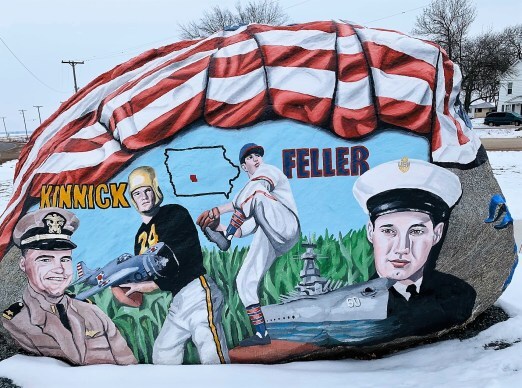 Nile Kinnick and Bob Feller, who are remembered on the north side of the Dallas County Freedom Rock®, were well-known to the Wilson brothers, who are remembered on the south side. They were from Dallas County towns whose schools played each other in sports.
Nile Kinnick and Bob Feller, who are remembered on the north side of the Dallas County Freedom Rock®, were well-known to the Wilson brothers, who are remembered on the south side. They were from Dallas County towns whose schools played each other in sports.
And all seven of these men served in WWII. Nile Kinnick won the Heisman Trophy in 1939 at the University of Iowa, where the stadium is named in his honor. The Kinnick family also lost another son, Lt. Benjamin Kinnick, a B-25 pilot in the Pacific.
From Leora Wilson’s memoir: “So many young folks do not remember Nile Kinnick of Adel, Iowa–a great football player. He was lost in the Caribbean (Navy Air Corps) in W. W. II. And Bob Feller of Van Meter, Iowa, a baseball pitcher. Delbert and Donald of Dexter played against their teams during their high school years in the 1930’s. They both admired those two boys–what great players they were.”
Her middle son Dale, Wilson also played against Bob Feller in 1936. “Van Meter has the best ball team in the county,” Dale reported to Delbert and Donald, who had joined the US Navy two years earlier, “and maybe in the state. Bob Feller is their pitcher and he has already been wanted by some teams. We played them and they beat us 13-0 and didn’t even try.” Bob Feller became a major league baseball pitcher, known as “the Heater from Van Meter,” who took four years from his career to served in WWII. He was later named to the Baseball Hall of Fame.
Leora Wilson would be surprised and blessed that her sons are honored on the same memorial stone as these two great athletes who also served in WWII. And that this Freedom Rock is in Minburn, not far from where, starting in 1939, Clabe Wilson and his sons were tenant farmers.
The Wilson brothers story. My journey of researching what happened to the three Wilson brothers who never came home.
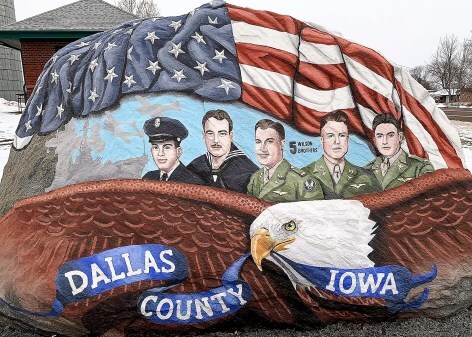 The Wilson brothers of Minburn: Donald, Delbert, Dale, Daniel, Junior
The Wilson brothers of Minburn: Donald, Delbert, Dale, Daniel, JuniorThe most recent issue (September 2024) of The American Legion Magazine has an article called “Crossed Paths in Adel,” about Nile Kinnick and Bob Feller, by historian Mike Chapman.
September 6, 2024
What’s a book that opened your eyes to a new perspective, and more. . .
September 6 is National Read a Book Day! How about one of these?
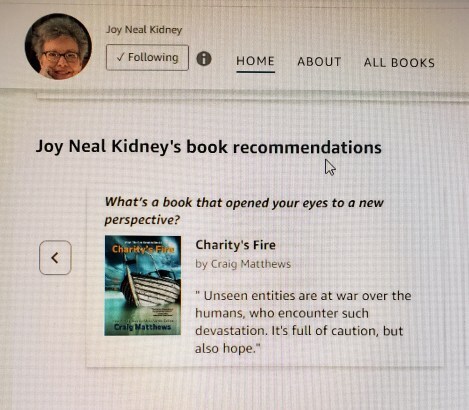 Amazon Author Page offers a chance to recommend books in specific categories, limiting the number of words you can include. I don’t know how anyone would happen onto this strip toward the bottom of my Amazon Author Page, but here are my choices:
Amazon Author Page offers a chance to recommend books in specific categories, limiting the number of words you can include. I don’t know how anyone would happen onto this strip toward the bottom of my Amazon Author Page, but here are my choices:
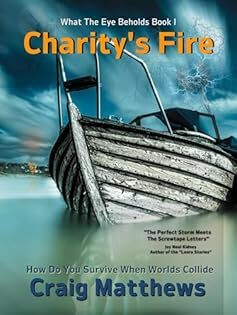 Charity’s Fireby Craig Matthews
Charity’s Fireby Craig Matthews
” Unseen entities are at war over the humans, who encounter such devastation. It’s full of caution, but also hope.”
What’s a book you couldn’t put down?What’s a similar book readers would like?Broken People: From the case files of Sheriff Will Diaz (ret) – A story of Redemption (The Lawman Book 3)by William Ablan
“It’s about policework, bad choices, family dynamics, PTSD, and second chances.”
What’s a book that left an impression on you?The Raffle Baby: An astounding lyrical novel inspired by a shocking true story of the Great Depressionby Ruth Talbot“This is the mesmerizing story of three youngsters caught up in the vortex of the Great Depression. “
 Above and Beyond: radio silenceby William A. Wright
Above and Beyond: radio silenceby William A. Wright“Based on the life of his father, Wright has written a masterful and introspective history of WWII. ”
What’s a book that is important to you?
 The Modern Christ: A Contemporary Retelling of the Story of Jesusby Dan Hambright“”The Modern Christ” is the ultimate “what if” story. What if Jesus were born in contemporary America?”
The Modern Christ: A Contemporary Retelling of the Story of Jesusby Dan Hambright“”The Modern Christ” is the ultimate “what if” story. What if Jesus were born in contemporary America?”
September 5, 2024
Lustron Houses

Our son and his family recently stayed in an airbnb that turned out to be a Lustron home.
The Des Moines area has a sprinkling of them but we’d never been inside one of these prefabricated enameled steel houses before. There was a shortage of homes after WWII so a Chicago industrialist and inventor, Carl Strandlund, came up with the idea of low maintenance houses which would also be very durable.
They set out to construct 15,000 homes in 1947 and 30,000 in 1948. The houses sold for between $8,500 and $10,500.
 With enameled steel panels inside and out, as well as steel framing, the homes were usually built on concrete slabs with no basement. The frame was constructed on-site and the house was assembled piece-by-piece from a special Lustron Corporation delivery truck. The assembly team, who worked for the local Lustron builder-dealer, followed a special manual from Lustron and were supposed to complete a house in 360 man-hours.
With enameled steel panels inside and out, as well as steel framing, the homes were usually built on concrete slabs with no basement. The frame was constructed on-site and the house was assembled piece-by-piece from a special Lustron Corporation delivery truck. The assembly team, who worked for the local Lustron builder-dealer, followed a special manual from Lustron and were supposed to complete a house in 360 man-hours.
Its plant in Columbus, Ohio, a former Curtiss-Wright factory, only built 2,498 Lustron homes from 1948 to 1950 because the company couldn’t pay back start up loans from the Reconstruction Finance Corporation.
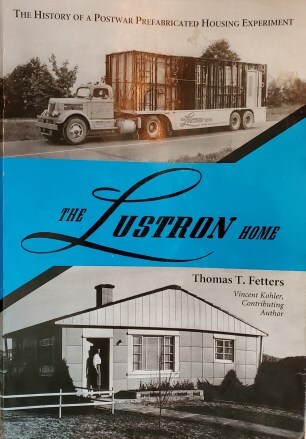
Many of these houses remain in use today. Several have been added to the National Register of Historic Places. The Lustron Houses of Jermain Street Historic District is a notable grouping and historic district in New York state. And some are popular as airbnbs.
A closeup look at a Lustron home.
September 3, 2024
Vintage Franciscan Desert Rose–Dishes of my Childhood
Pink and Green
Favorite memories of meals at home included Mom’s Desert Rose dishes. Even before she could afford to buy settings of it, she’d fallen in love with it during WWII and bought the rosebud salt and pepper shakers and the darling individual ash trays. Yes, ash trays, but I never saw Dad flick ashes from his unfiltered Camels in one.
When Dad installed Mom’s white Youngstown kitchen cabinets with black countertops. She decorated the kitchen in pink and green, and served porkchops with potatoes and gravy on luncheon sized Desert Rose plates. Colors of my childhood.
I didn’t want china when we got married. I bought Melmac to take to Idaho where Guy was stationed before Vietnam. When we eventually settled down, I admitted that I still didn’t want fine china but I’d enjoy having some Desert Rose dishes like I grew up with. Mom and Guy both enjoyed gifting me something in that pattern, especially if they could find it American made (yes, you can tell the difference), until I sure had a collection of it!
Grandma Leora was here for her last Mother’s Day celebration. I later realized I’d used those dishes against a pink tablecloth covered with one she’d crocheted. After Guy asked the blessing, Grandma leaned over to me–in that perky way she went about such things–and asked, “Do I recognize something?” Indeed, little Grandma. What a blessed memory. 1987
 Grandma’s crocheted roses cloth with Mom’s Desert Rose s&p rosebuds and darling ash trays. (I’ve never allowed ashes in those dear little dishes, and I bet Mom didn’t either!)
Grandma’s crocheted roses cloth with Mom’s Desert Rose s&p rosebuds and darling ash trays. (I’ve never allowed ashes in those dear little dishes, and I bet Mom didn’t either!)We’re in the season of downsizing. Son Dan and his wife Renee aren’t interested in the Desert Rose dishes. I let most of them go when Mom’s things were auctioned.
But I kept my mother’s old Desert Rose from the farm along, along with those rosebud salt and pepper shakers and the ash trays.
August 29, 2024
Blessed by a Long-lived Motherline
Great Great Great Great Grandmother Jane left family behind in Tennessee, so I don’t know how long she had the benefit of her mother and grandmother.
Her daughter Lucy was 32 when she left her mother (Jane) behind in Indiana to pioneer in Iowa. They probably wrote letters to one another, but Lucy never saw her mother again.
Lucy’s daughter Emilia was just 8 years old when she came to Iowa, so she only knew her grandmother (Jane) that long. Emilia was 36 when her mother (Lucy) died.
Emilia’s oldest daughter Laura was 14 when she lost her grandmother (Lucy), and 46 when her mother (Emilia) died.
Laura’s oldest daughter Leora was 24 when she lost her grandmother (Emilia), and nearly 72 when her mother (Laura) died. She spent time with her grandmother, sometimes living with her after she was widowed. Leora’s mother was such a blessing to her while she raised her family. They lived together a dozen years after both were widowed. Leora spent time with her grandchildren and great grandchildren.
Leora’s oldest daughter Doris was 44 when she lost her grandmother (Laura), and 69 when her mother (Leora) died.
Doris’s oldest daughter Joy was 18 when my great grandmother (Laura) died, 43 when I lost my grandmother (Leora), and 71 when my mother died. What a blessing!
 Four generations: Laura (Jordan) Goff, Leora (Goff) Wilson, Doris (Wilson) Neal, Joy Neal. Guthrie Center, Iowa, 1950s
Four generations: Laura (Jordan) Goff, Leora (Goff) Wilson, Doris (Wilson) Neal, Joy Neal. Guthrie Center, Iowa, 1950sWhen four generations were together at Grandma’s in Guthrie Center, I didn’t think it was unusual. I wish I hadn’t taken those grandmothers for granted. To share so many of those years, I was being mentored in so many ways without realizing it.
While wondering whether my grandmothers also enjoyed this incredible gift, I noticed that the longest-lived women, overlapping with an extra generation, were especially beneficial to Leora. What a gift to a woman who endured so many losses and hardships during her ninety-seven years.
For the LORD is good and his love endures forever; his faithfulness continues through all generations. – Psalm 100:5
August 27, 2024
First Ad in Our Iowa Magazine
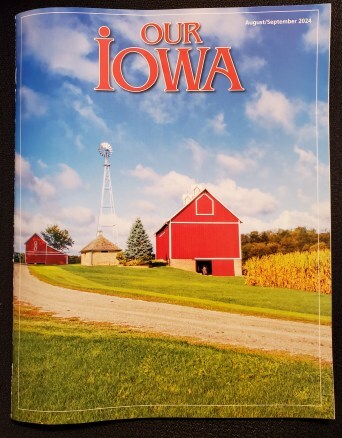 We’ve subscribed to the beautiful Our Iowa magazine for years. We’ve had a couple of old photos published in the Rewind section (Guy as a farm boy riding a cow during the 1950s, and the two oldest Wilson brothers standing in front of the Model T truck as they prepared to leave for the Navy, 1934), but I’d never placed an ad with them for the Leora books.
We’ve subscribed to the beautiful Our Iowa magazine for years. We’ve had a couple of old photos published in the Rewind section (Guy as a farm boy riding a cow during the 1950s, and the two oldest Wilson brothers standing in front of the Model T truck as they prepared to leave for the Navy, 1934), but I’d never placed an ad with them for the Leora books.
The very first one is in the August/September 2024 issue, naming the three places in the Des Moines area that offer autographed copies.
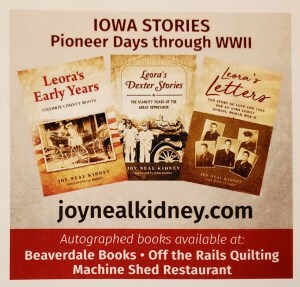
Not only that, but Our Iowa holds drawings for prizes to its readers for reading the ads. We advertisers pay for their ads in part by giving away products or services. Readers hunt for a tiny “I” in three ads, jotting them on a postcard to send in for the drawings.
I’ve been told that some subscribers hunt for the tiny “I” symbols as soon as the new issue arrives. What a fun addition to such an inviting collection of glossy photos and winsome stories.
For this issue, I’m offering a gift card to Beaverdale Books in Des Moines, who carry autographed copies of the Leora books, plus they offer shipping.
Friends from Guthrie Center have already spotted the tiny ad! (I didn’t find a tiny “I” in it.) May these ads connect readers with the compelling stories of a diminutive Iowa woman who lived with terrible losses, yet with tenacity and grace.
August 23, 2024
What a good, round friend you are! – Owl
With a bright moon following me home during my daybreak walk, especially welcome this week, I am reminded of the story of “Owl and the Moon”: “Moon, you have followed me all the way home. What a good, round friend you are!”
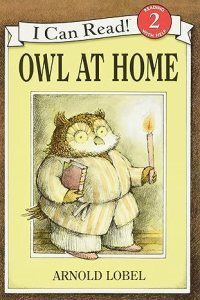 The story is from Arnold Lobel’s Owl at Home, a favorite “I CAN READ Book” from 1975. Later that decades, son Dan and I enjoyed the five delightful stories in it: “The Guest,” who turned out kinda pushy, “Strange Bumps,” which were more benign that naive Owl thought, “Tear-Water Tea,” which I enjoyed reading tearily, “Upstairs and Downstairs,” with poor Owl finding out he couldn’t be both places at once, and the dear “Owl and Moon.”
The story is from Arnold Lobel’s Owl at Home, a favorite “I CAN READ Book” from 1975. Later that decades, son Dan and I enjoyed the five delightful stories in it: “The Guest,” who turned out kinda pushy, “Strange Bumps,” which were more benign that naive Owl thought, “Tear-Water Tea,” which I enjoyed reading tearily, “Upstairs and Downstairs,” with poor Owl finding out he couldn’t be both places at once, and the dear “Owl and Moon.”
Arnold Lobel was such a favorite author while Dan was small. He wrote the Frog and Toad series, Mouse Tales and Mouse Soup, and more.
We wrote fan letters to the author. His reply was such a delight, including a sketch of Owl himself. “Dear Mrs. Kidney and Dan, Thanks so much for your nice letters. I am delighted to hear that I have such ardent fans in Iowa. My newest book will be Fables and it will be published in the fall of this year. Here is a sketch of Owl for you. Your friend, Arnold Lobel”
Fables won the 1981 Caldecott Medal for the artist of the most distinguished American picture book for children published in the U.S. during the preceding year, so the letter must have been written in 1980.
Our treasured copies of the “Lobel books,” along with others, are about to go home with granddaughter Kate. I hope she enjoys them as much as we did. I hope that when the moon follows her home, the words “What a good, round friend you are!” will also follow her home.
August 22, 2024
Coded in the Hospital: Thank God for Nurse Susan and Narcan!
Nurse Linda had a new patient late afternoon, August 24, 2016, who’d just had hernia surgery. She noticed that her oxygen level was dangerously low, so she used another machine, which read the same.
Linda hit the “code” button on the wall while she began meds (a shot, I think) to rid the patient (me) of pain meds and worked with a rebreather, trying to get me to respond. The room quickly filled up with hospital personnel, including the chaplain, with more in the hallway. I remember Linda trying to get me to wake up, to open my eyes.
After listening to the assistant surgeon ask the nurse several questions, Guy heard him tell her, “Nice save.” Thank you, Almighty God, for my life. . . . and for Nurse Linda, 8th Floor south, Mercy downtown. She later told us she’d never had a patient measure that low on oxygen and make it out alive!
I’d had a much more serious surgery that January, which set me up for this one, but had not been overdosed with pain meds while still in the ICU.
 Total reverse shoulder replacement, February 2020. No overdose!
Total reverse shoulder replacement, February 2020. No overdose!When I had a shoulder replaced in 2020, I had no pain meds in the hospital. A “neck block” took care of the pain until I was home, lucid, and could take care of my own meds.
I’m very thankful for modern medicine, and very thankful to still be useful this side of heaven!
August 21, 2024
An Awesome Connection

Thanks to the nudges and efforts of Debbie Menning and Vanessa Branson, autographed copies of the Leora books are available in Art on State, right in the town where Grandma Leora lived for decades, Guthrie Center, Iowa!
Thanks also to my sister Gloria for delivering them.
 Guthrie Center is the county seat of Guthrie County. My sister lives near Dexter, which is in the SW corner of Dallas County. I live in Polk County, which is to the east of Dallas County.
Guthrie Center is the county seat of Guthrie County. My sister lives near Dexter, which is in the SW corner of Dallas County. I live in Polk County, which is to the east of Dallas County.This 1911 map shows places Leora lived from her girlhood. She was born in the county in 1890. Her family also lived in Audubon County, just west of Guthrie, near Larland. She rode a horse to piano lessons in Audubon, attended sewing school in Exira, just south of Audubon.
Leora Goff married Clabe Wilson at her folks’ home at Wichita, above the T in Guthrie. They first met and also lived near Monteith when they were first married.
There are several stories in Leora’s Early Years set in Stuart, in the SE corner, along the Rock Island railroad. You can see where the branch train, affectionately called the Liza Jane, between Menlo and Guthrie Center.
 Leora!
Leora!Leora Goff Wilson lived in Guthrie Center for four decades after the war. I have a soft spot for that town, for the whole county after visiting my cheerful and tenacious grandma there dozens of times and learning the stories of her growing up years and early years of marriage.
I’m grateful that her stories are more easily available in her own home town.
August 20, 2024
Questions to Ponder: Leora’s Early Years: Guthrie County Roots
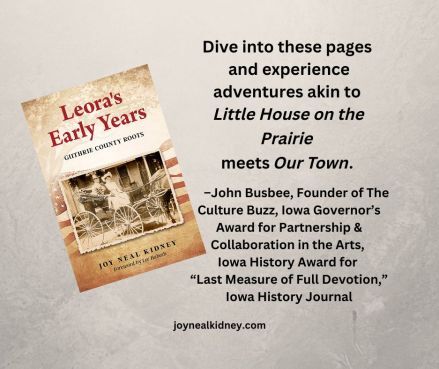
Questions to Ponder can help get a conversation started after a book club gathers after reading a chosen book. The questions are also interesting to work through for any reader. These are from Leora’s Early Years, which begins with pioneer Iowans and ends during the 1920s:
Questions to Ponder
How was life different for children when Leora was growing up? What did families do for entertainment? Would you have liked to grow up during those days?2. Kem Luther, in Cottonwood Roots, said that Nebraska homesteaders knew there was “a line out there where the rain ended. . . We know today that this line twists its way through the heart of Nebraska like a rattlesnake. . . . But when the droughts of the nineties came it was clear that the snaking line was a sidewinder. . .” Why were the Goffs and other pioneers so unaware of the problems they could encounter? Did the newspaper ads offer them a false hope?
3. What do you think about Sherd Goff’s not allowing his older children to attend high school?
4. How would you compare women’s lives then to now? Were some things better back then?
5. A study of 1741 cases of insanity by Edward Jarvis, published by the US Commissioner of Education in 1871, concluded that “over-study” was responsible for 205 of the insanity cases. He wrote, “Education lays the foundation of a large portion of the causes of mental disorder.” How well do you think mental health was diagnosed and treated decades ago?
6. Do you suppose that Georgia Goff might have suffered from a brain tumor?
7. A person’s character is forged during their early years as they go through the blacksmithing concepts of “heating and hammering.” What might these early stories reveal about Leora’s character, where it came from? What about Clabe?
8. What do you think happened in Georgia Wilson’s first marriage? Why would she give up her first son so easily? Is it fair to conjecture this many years later?
9. Clabe and Leora’s marriage may not have been “made in heaven,” but what do you think made it work?
Leora’s Early Years is also available as an audiobook, done with Virtual Voice. You may listen to a sample under the book cover.



